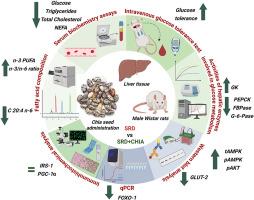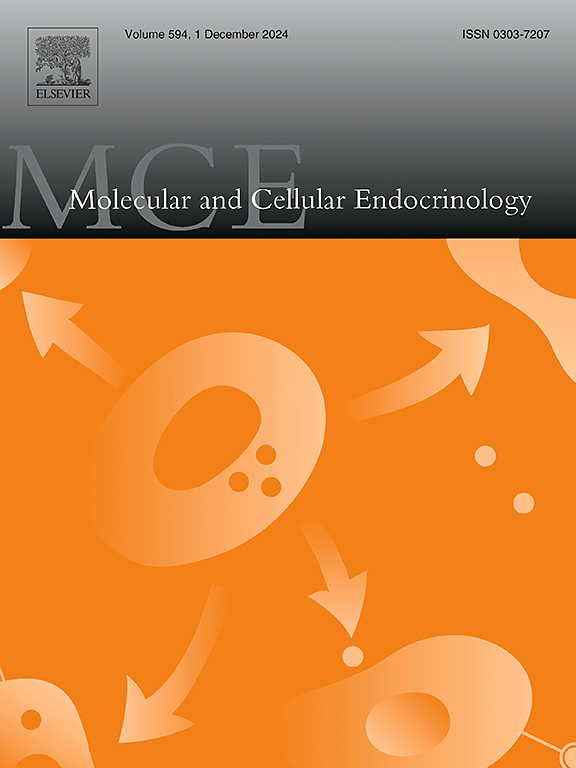富含α-亚麻酸的奇亚籽改善糖耐量,调节糖异生途径和肝脏胰岛素信号通路
IF 3.6
3区 医学
Q2 CELL BIOLOGY
引用次数: 0
摘要
代谢功能障碍相关脂肪变性肝病(MASLD)是公认的代谢综合征的肝脏表现。本研究旨在探讨富含α-亚麻酸的奇亚籽对富蔗糖日粮大鼠糖耐量、糖异生相关酶活性、转录因子及胰岛素信号通路关键分子的影响。雄性Wistar大鼠饲喂参考日粮(RD) 6个月,SRD饲喂3个月。后一组随机分为两个亚组。一个亚组继续接受SRD长达6个月,另一个亚组在接下来的3个月里,在SRD中加入奇亚籽作为膳食脂肪的来源(SRD + chia)。结果表明,奇亚籽改善了葡萄糖耐量,逆转了PEPCK、FBPase和glucose -6- pase的升高,降低了glucose -6- pase /GK比值。此外,奇亚籽提高了tAMPK和pAMPK蛋白水平,同时维持了与RD组相似的GLUT-2蛋白水平。胰岛素刺激下,SRD + CHIA组p-AKT蛋白水平高于未刺激组。3个实验组中IRS-1和PGC-1α蛋白表达水平相似。SRD + CHIA组肝脏FOXO-1 mRNA表达降低。最后,奇亚籽提高了肝膜磷脂的n-3/n-6比值。本研究表明,奇亚籽可通过多种机制调节SRD喂养大鼠的葡萄糖代谢和胰岛素信号。这些作用至少部分是由肝组织中n-3 PUFAs的富集介导的。本文章由计算机程序翻译,如有差异,请以英文原文为准。

α-Linolenic acid rich-chia seed improves glucose tolerance, modulates gluconeogenic pathway and hepatic insulin signaling in an experimental model of metabolic syndrome
Metabolic dysfunction-associated steatotic liver disease (MASLD) is recognized as the hepatic manifestation of Metabolic Syndrome. The aim of this work was to evaluate the effects of chia seed, rich in α-linolenic acid, on glucose tolerance, enzyme activities and transcription factors involved in gluconeogenesis, and key molecules in insulin signaling in sucrose-rich diet (SRD) fed rats. Male Wistar rats were fed a reference diet (RD) for 6 months or a SRD for 3 months. Then, the latter group was randomly divided into two subgroups. One subgroup continued receiving SRD for up to 6 months and the other was fed with a SRD where chia seed was incorporated as a source of dietary fat for the next 3 months (SRD + CHIA). The results showed that chia seed improved glucose tolerance, reversed the increase in PEPCK, FBPase, and Glucose-6-Pase, and reduced the Glucose-6-Pase/GK ratio. Additionally, chia seed improved tAMPK and pAMPK protein levels, while maintaining GLUT-2 protein levels similar to those in the RD group. Under insulin stimulation, p-AKT protein levels were higher in the SRD + CHIA group than in the unstimulated group. IRS-1 and PGC-1α protein expression levels were similar among the three experimental groups. Liver FOXO-1 mRNA expression was decreased in the SRD + CHIA group. Finally, chia seed increased the n-3/n-6 ratio in hepatic membrane phospholipids. The present study demonstrated that chia seed modulate multiple mechanisms that enhance glucose metabolism and insulin signaling in SRD fed rats. These effects are mediated, at least in part, by the enrichment of n-3 PUFAs in liver tissue.
求助全文
通过发布文献求助,成功后即可免费获取论文全文。
去求助
来源期刊

Molecular and Cellular Endocrinology
医学-内分泌学与代谢
CiteScore
9.00
自引率
2.40%
发文量
174
审稿时长
42 days
期刊介绍:
Molecular and Cellular Endocrinology was established in 1974 to meet the demand for integrated publication on all aspects related to the genetic and biochemical effects, synthesis and secretions of extracellular signals (hormones, neurotransmitters, etc.) and to the understanding of cellular regulatory mechanisms involved in hormonal control.
 求助内容:
求助内容: 应助结果提醒方式:
应助结果提醒方式:


